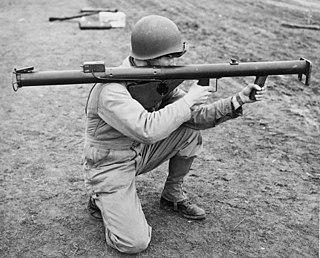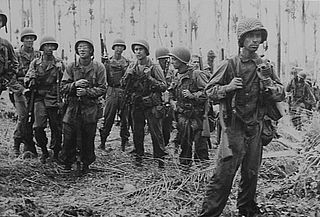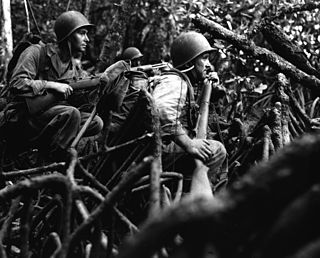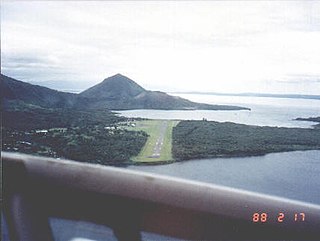Related Research Articles

Bazooka (/bəˈzuːkə/) is the common name for a man-portable recoilless anti-tank rocket launcher weapon, widely deployed by the United States Army, especially during World War II. Also referred to as the "Stovepipe", the innovative bazooka was among the first generation of rocket-propelled anti-tank weapons used in infantry combat. Featuring a solid-propellant rocket for propulsion, it allowed for high-explosive anti-tank (HEAT) warheads to be delivered against armored vehicles, machine gun nests, and fortified bunkers at ranges beyond that of a standard thrown grenade or mine. The universally-applied nickname arose from the M1 variant's vague resemblance to the musical instrument called a "bazooka" invented and popularized by 1930s U.S. comedian Bob Burns.

This article is about the weapons used in the Vietnam War, which involved the People's Army of Vietnam (PAVN) or North Vietnamese Army (NVA), National Liberation Front for South Vietnam (NLF) or Viet Cong (VC), and the armed forces of the Army of the Republic of Vietnam (ARVN), United States, Republic of Korea, Philippines, Thailand, and the Australian, New Zealand defence forces, and a variety of irregular troops.

The Division of Hinkler is an Australian Electoral Division in Queensland.

The Type 97 Hand Grenade was the standard fragmentation hand grenade of the Imperial Japanese Army and Imperial Japanese Navy SNLF during the Second Sino-Japanese War and World War II.

Operation Chronicle was the Allied invasion of Woodlark and Kiriwina Islands, in the South West Pacific, during World War II. The operation was a subordinate action that formed part of the wider Operation Cartwheel, the advance towards Rabaul. An early planning name for this operation was Operation Coronet. Preliminary actions commenced on 23–24 June 1943 when small reconnaissance parties were landed on both islands. The main operation was executed without opposition on 30 June 1943. Around 16,800 personnel took part, divided into two forces. The United States Army provided the majority of ground troops, which were supported by a United States Marine Corps defense battalion as well as U.S. and Australian aircraft and naval vessels.

The 3rd Marine Aircraft Wing is the major west coast aviation unit of the United States Marine Corps. It is headquartered at Marine Corps Air Station Miramar, in San Diego, California and provides the aviation combat element for I Marine Expeditionary Force. The wing is made up of a headquarters squadron, four flying groups, an aviation command and control group and an aviation engineering group.

The New Guinea campaign of the Pacific War lasted from January 1942 until the end of the war in August 1945. During the initial phase in early 1942, the Empire of Japan invaded the Australian-administered Mandated Territory of New Guinea and the Australian Territory of Papua and overran western New Guinea, which was a part of the Netherlands East Indies. During the second phase, lasting from late 1942 until the Japanese surrender, the Allies—consisting primarily of Australian forces—cleared the Japanese first from Papua, then the Mandate and finally from the Dutch colony.

The New Britain campaign was a World War II campaign fought between Allied and Imperial Japanese forces. The campaign was initiated by the Allies in late 1943 as part of a major offensive which aimed to neutralise the important Japanese base at Rabaul, the capital of New Britain, and was conducted in two phases between December 1943 and the end of the war in August 1945.

Nissan Island is the largest of the Green Islands of Papua New Guinea. It is located at 4°30′S154°13′E, about 200 km east of Rabaul on New Britain and about 200 km north-west of Bougainville. The island is administered under Nissan Rural LLG in the Autonomous Region of Bougainville.

Kako was the second vessel in the two-vessel Furutaka class of heavy cruisers in the Imperial Japanese Navy. The ship was named after the Kako River in Hyogo prefecture, Japan.
Suzunami was a Yūgumo-class destroyer of the Imperial Japanese Navy.

The Battle of Vella Lavella was fought from 15 August – 6 October 1943 between Japan and the Allied forces from New Zealand and the United States at the end of the New Georgia campaign. Vella Lavella, an island located in the Solomon Islands, had been occupied by Japanese forces early during the war in the Pacific. Following the fighting around Munda Point, the Allies recaptured the island in late 1943, following a decision to bypass a large concentration of Japanese troops on the island of Kolombangara.

The Japanese Eighth Area Army was a field army of the Imperial Japanese Army during World War II.

Marine Transport Squadron 152 (VMR-152) was an air transport of the United States Marine Corps that was responsible for the movement of personnel, equipment, and supplies. The squadron flew fixed-wing cargo aircraft to include the R4D Skytrain and the R4Q Flying Boxcar. The squadron saw combat during World War II and the Korean War with their most notable contributions coming during the Battle of Guadalcanal and during the Marine breakout during the Battle of Chosin Reservoir. The squadron was decommissioned in the late 1950s.

Lakunai Airfield, later known as Rabaul Airport; was an aerodrome located near Rabaul, East New Britain, Papua New Guinea. It was located at the foot of Tavurvur volcano, near Matupit Island. The airport was destroyed by the 1994 eruption that destroyed the town of Rabaul and subsequently a new airport was built and opened at Tokua, on the opposite side of the Rabaul caldera. The former airport was located at 04°13′S152°11′E.

Kerevat Airfield was an aerodrome located near Kerevat, East New Britain province, Papua New Guinea. Situated on the northern coast, it was 13 miles (21 km) south west of Rabaul. The airfield was constructed by the Imperial Japanese in World War II during September 1943. Kerevat Airfield was neutralized by Allied Powers' air bombing from 1944, who ran missions on the airfield between June 20, 1943, and May 16, 1944. The airfield was abandoned after the cessation of hostilities; however, the airstrip is still visible.
Blanche Bay is a bay near Rabaul, New Britain, Papua New Guinea. The bay is named after HMS Blanche, which surveyed the bay under the command of Captain Cortland Simpson in 1872.

The Battle of Karavia Bay occurred in February 1944 and was the first surface engagement fought in the Rabaul area of New Britain during the Solomon Islands Campaign. A squadron of United States Navy warships attacked the harbor defenses of Karavia Bay and exchanged naval gunfire and torpedoes with two Japanese destroyers. The nighttime engagement ended with the silencing of the Japanese artillery and resulted in a blockade of the port. Two Japanese transports were also sunk in the fighting. Later, Allied forces landed on the island and destroyed the enemy garrison.

The Warangoi River also known as the Adler River, is a river located in the eastern part of the Gazelle Peninsula in the north-eastern part of New Britain, Papua New Guinea. It flows past the village of Warangoi and out into the Warangoi Bay. It played a part in the Battle of Rabaul early in 1942. Lieutenant Colonel Ishiro Kuwada's men of the 3rd Infantry Battalion captured at least 200 Australian men between the Warangoi River and Vunakanau. Virgin rainforest lies along the river basin.
W-26 was a W-19-class minesweeper operated by the Imperial Japanese Navy during World War II.
References
- Rottman, Gordon L. (2001), World War II Pacific Island Guide: A Geo-Military Study, Greenwood Press; Santa Barbara, CA. ISBN 0-313-31395-4
Coordinates: 4°18′S152°11′E / 4.300°S 152.183°E
| | This East New Britain Province geography article is a stub. You can help Wikipedia by expanding it. |